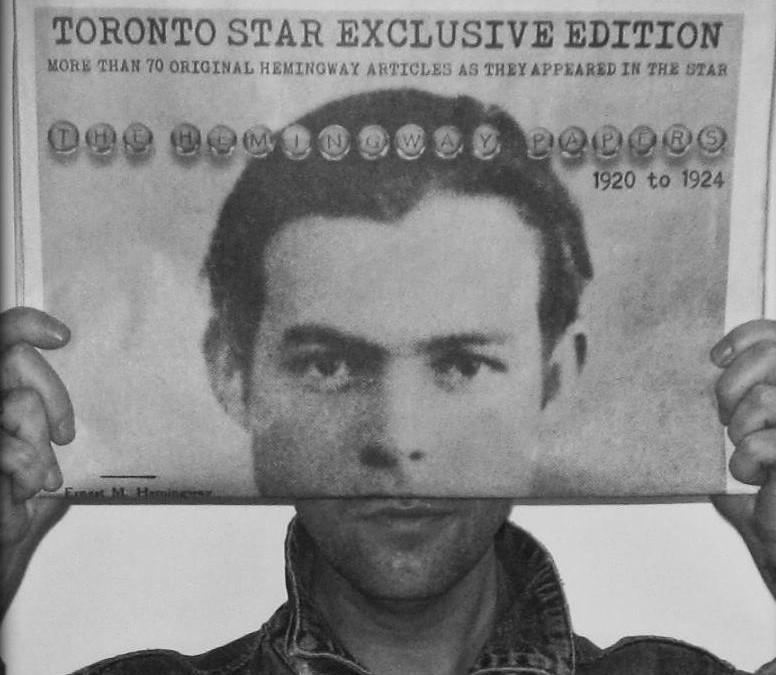
by Brad Puet | Jun 16, 2014 | Brad Puet, Stories
Storyteller Series: Matthew Wylie by BP
As a member of Grryo, I frequently look through the hashtags of #wearejuxt #mobilephotography and now #grryo on all the social networks. First I find it interesting to see what people would share on these tags and secondly its a great way to meet creatives who share commonalities through mobile photography. The new Grryo tag already has over a 1000 photos in a few days and I totally gravitated to a handful of photos that were posted on Instagram by Matthew. I wasn’t the only one as that same day, Anna (who is also an editor of Grryo) hit him up for an interview. Needless to say, Matthew’s work is amazing and great and all things awesome and we wanted to share with our readers this storyteller from Toronto!
BP: BP MW: Matthew Wylie
BP: Tell us where you are from. Tell us about your family. Tell us about your non-photo inspirations (other artists, books, etc.).
MW: I’m from Texas, where I spent most of my life. My blood family is there as well, but I have been living and teaching in Canada for the last seven years. My professional background is in literature and writing, and, since I was a young kid, I have always been very drawn to stories, words, and art in general. In terms of artists most important to me? – Nabokov, Kafka, and Borges. The enchantment that each of those writers can place on words, symbols, and the story itself has always been magical to me. So, that general aesthetic definitely influences my work. And of course Rainer Maria Rilke, his “Letters to a Young Poet,” – this work has always been such an important influence on how I approach the world and my art. The line “if your daily life seems poor, do not blame it; blame yourself, tell yourself that you are not poet enough to call forth its riches” is particularly inspiring to me and I certainly use this as a constant motivation to find, see, document, or create the beauty and mystery that’s out there, every day.
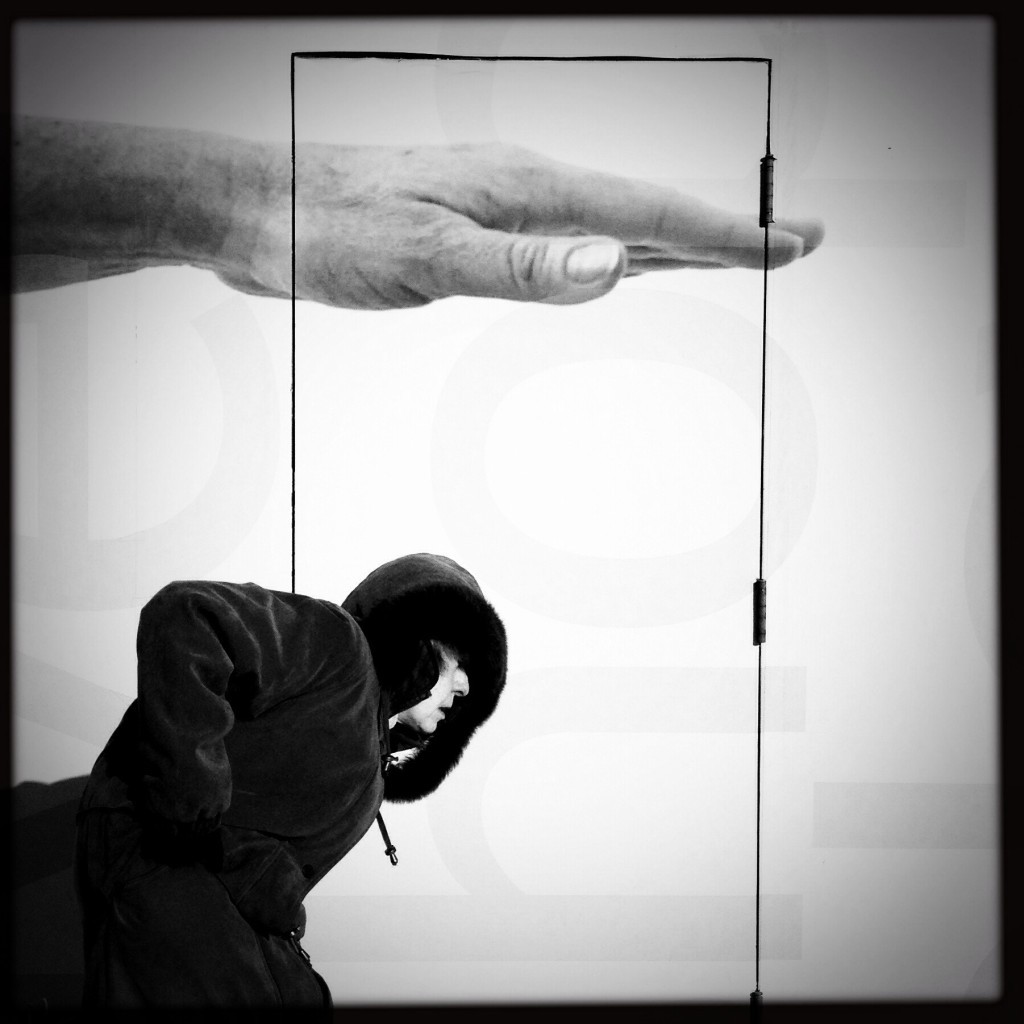
“The struggle itself towards the heights is enough to fill the heart. One must imagine Sisyphus happy.” – Albert Camus This photo was taken in Toronto, where I live. It was shot during the very difficult and long winter we had this year, with about 6 months of bleak, blistering cold days. I was on my way to the market when I noticed this massive billboard with the hand and I saw the subject approaching. Her body movement, her face – it just all embodied what I think we were all feeling about the winter and, despite its brutal nature, she was braving it. It was such a testament of the human spirit and I was immediately reminded of Camus’ quote on Sisyphus (see “The Myth of Sisyphus”) regarding the idea of finding meaning in the struggle, of forging our own authentic meaning, despite the absurdity and harshness of our daily lives. Meaning is not out there to be found. It exists within ourselves, as Camus intimated, and I feel like this photo illustrates that tenet.
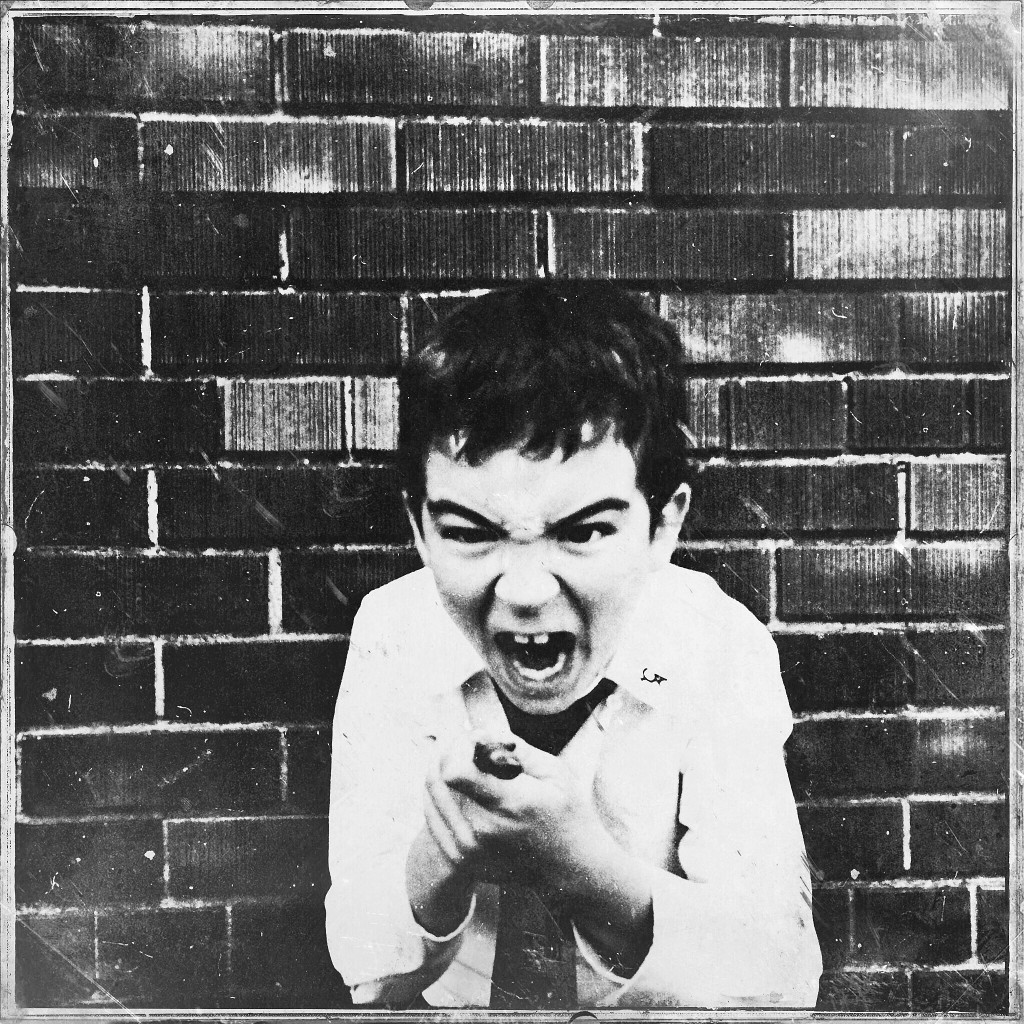
“This will never end because I want more.” – Fever Ray Taken in Toronto near a playground where I work and pass by daily. The boy was playing with a stick as if it were a gun with his peers and I was able to walk past and capture one from the hip that. While it took a bit of editing, it ended up working and conveying this mad, beautiful sense of energy, maybe even angst (?). The audacious look on his face reminded me of the lyric from one of my favourite bands, Fever Ray. I love the coupling of the mood with the song – again, the creative exchange, at least for me, lends itself to other mediums and this one was musical in nature.
BP: How’d you start in photography and what brought you into the realm of street photography?
MW: Oh, I’ve always taken photos – I’ve just never owned a good camera. Like, I would go through Kodak disposables weekly during high school, and then moved on to cheap, handheld digital cameras that just took horrible photos! I had a Polaroid that was fun in university, but the film cost too much for me to naturally produce. Visual imagery, especially photography, has always been special to me though. I could never draw or paint very well, but I could take pictures, so that was my visual medium. However, I didn’t get serious with my work until recently, like within the last year or so, when I got my first iPhone (the 4S). That totally changed everything for me. I now had this tool in my hand that could complement my vision and help me communicate the way I’ve always wanted to and knew that I could. What got me into street photography? I’m not entirely sure, really. I have always been drawn to artwork that is a bit raw, or . . . at least not traditional. So, I think that has something to do with it. Once I started exploring the genre and seeing what others have done with it, I just knew it was what I wanted to pursue. I don’t want to call myself a “street photographer” though. I think I just use the streets more than any other subject to tell my story, or to capture the type of images I am seeking to capture and convey to others.
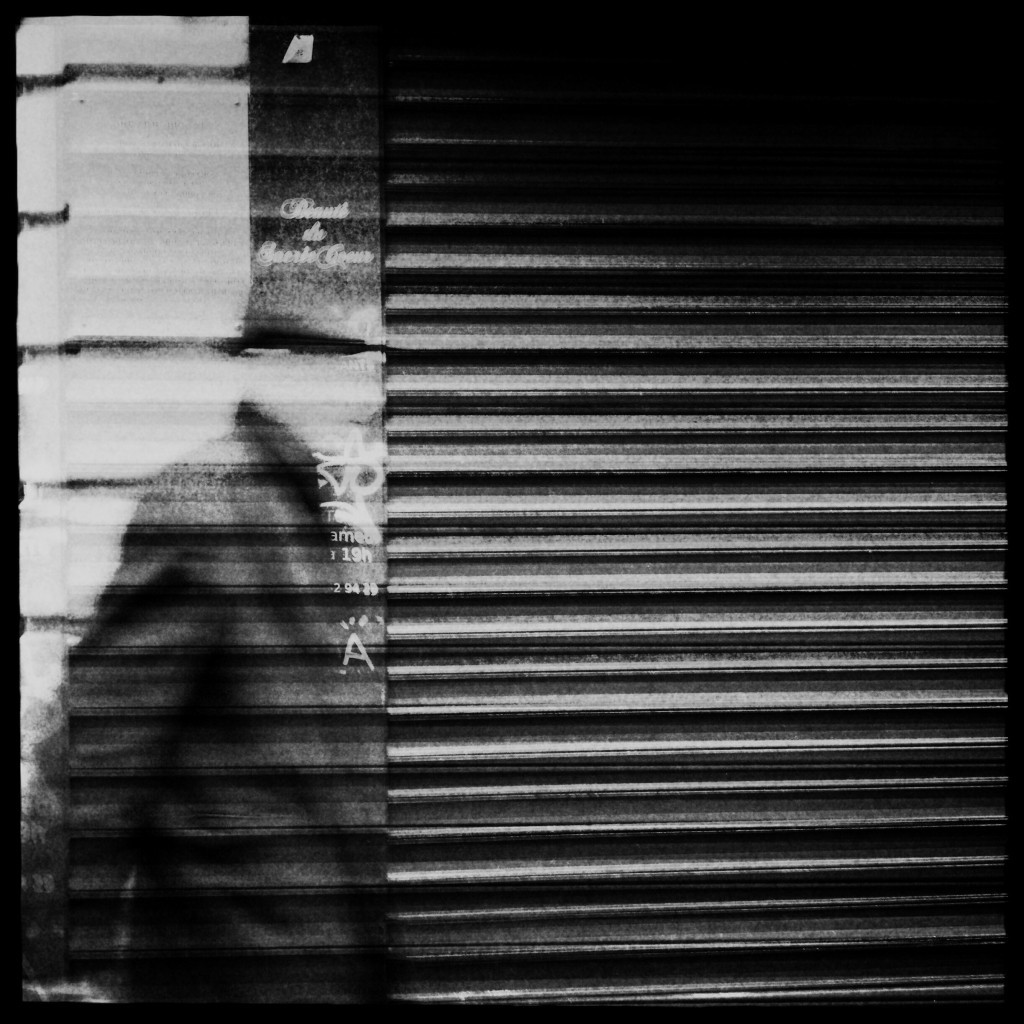
“Symmetry is what we see at a glance.” – Pascal Taken in Paris, France. I adore this photo because it illustrates Lange’s quote (see above) but in a different manner. When I originally saw this photo on my phone, it didn’t look like much, but after seeing it on the larger screen, it itself up to me and I was just so swept away with what I didn’t initially see in the photo. This all speaks to a larger issue I think regarding the way technology, particularly viewing art in a variety of mediums, can change the way we appreciate the aesthetic qualities of a piece of art, especially a photo. For example, oftentimes, I (we) have taken a photo and, while it seems decent on the iPhone, is only mediocre when viewed on a larger screen. However, does that discount the original aesthetic moment we shared with our first viewing? Since these are primarily digital images we are dealing with, can we not speak of a multiplication of the same image, depending on the medium it is viewed in, e.g. iPhone, iPad, Desktop, a blown up piece for a gallery wall, the way we remember the image weeks later?
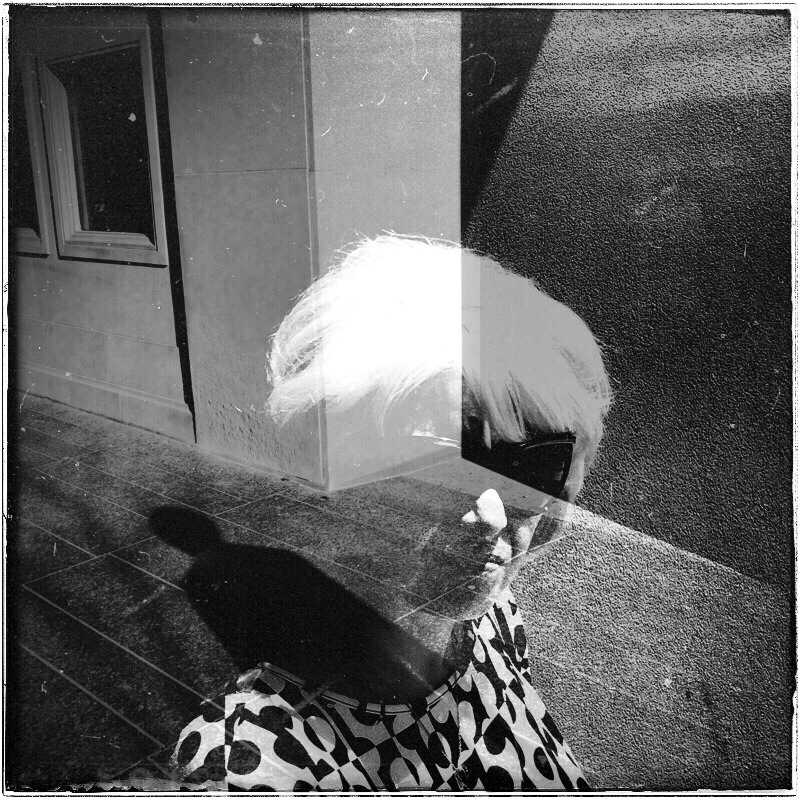
“Maybe all men got one big soul, and everybody’s a part of it—all faces of the same man, one big self. Everyone looking for salvation for himself. Each like a coal drawn from the fire.”- Malick Taken in Toronto. I have always been drawn to Terrence Malick’s films. They read like filmic tone poems and this capture / edit to me encapsulates a line from one of Malick’s best, The Thin Red Line. The irony that, for me, the act of going out in the streets is such a solitary endeavor, yet, that the final outcome can provide so much connection to others, either through social platforms or whatever, is just wondrous. To the wonder . . .
BP: Your photos are captivating, as you automatically think as a viewer, “what is the story here? What is the artist’s message?” Explain to us a process for you to achieve this connection to the viewer.
MW: Thank you for that! Well, to be honest, I am not sure it is something entirely, or even remotely, conscious. But I do think of it as an exercise in reading. In my writing courses, we often discuss the concept of reading images as texts, and learning to read well is essentially the same thing as learning to see well. The world is full of texts and subtexts and sub-subtexts – just layer after layer after layer – and these texts aren’t simply written, but visual as well. We read images as texts and we’re not even conscious that we’re doing so. We’re always reading – at least those of us who are looking. So when I am out on a walk through the streets, I am constantly looking for that text that my camera will capture and will, hopefully, be able to communicate something, even if it is a recognizable emotion, or a memory even. In terms of my connection with the viewer, I am, with all due respect, never thinking of the viewer. I am not thinking a lot, actually. Just scanning with my eyes the building blocks for the story, which could range from another actual human being to a shaft of light in an alleyway to the colours in a window reflection. Once I have these tools, then I think we can begin the sharing process. I guess . . . think of it as if I have read a story and want to retell it to you. This is what the photograph is. It’s a retelling of a visual I was witness to. Once I share it with you though, it’s no longer my narrative; it’s yours. And this is the beauty of storytelling, whether with the written words or with an image. The narrative is never static.
Series: Where are you going, where have you been?
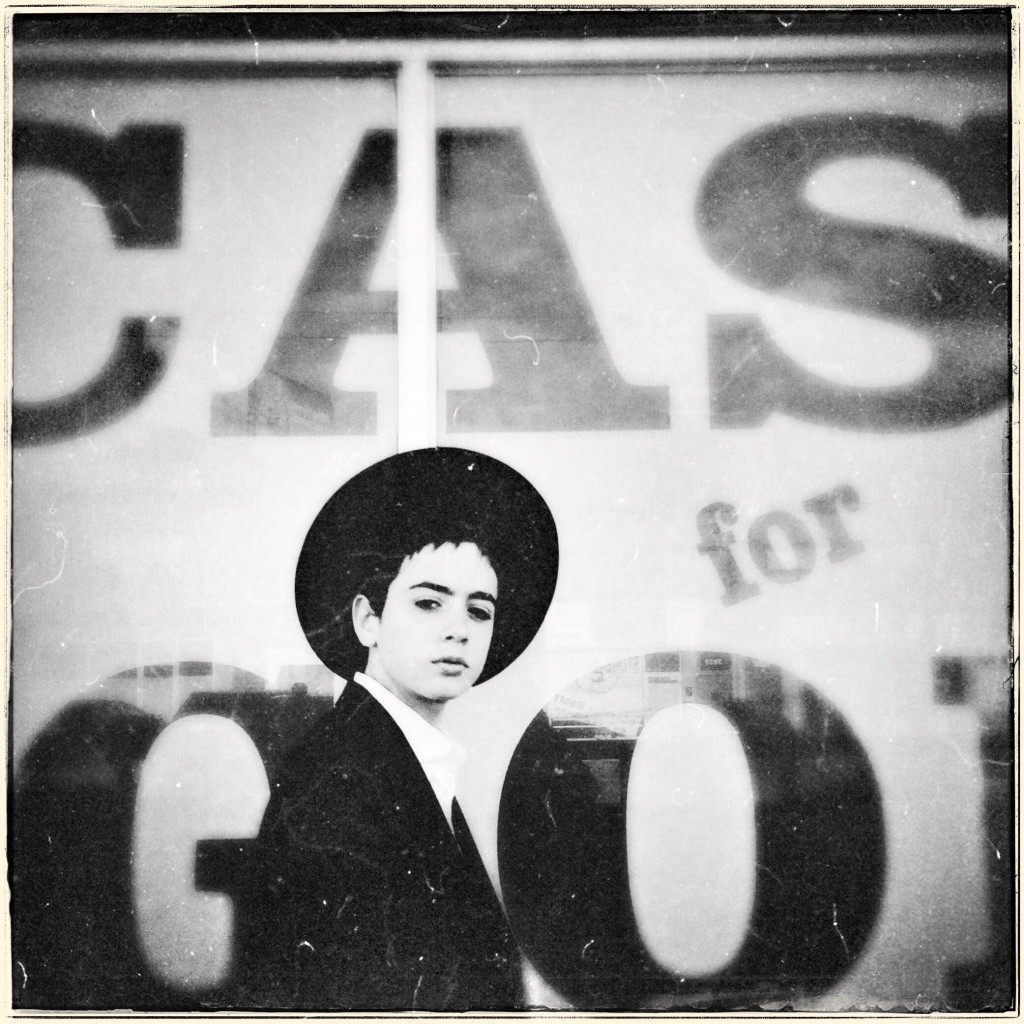
Where are you going, where have you been? This was taken in Toronto in a neighbourhood that is primarily inhabited by Hasidic Jews. It is a difficult area to photograph in for various reasons: as a visible outsider, it is far less easy to be invisible, there is a heightened sensitivity on my part for what I am capturing and not capturing, and then this sort of strange, somewhat eerie feeling of unease portrayed in the body language of the community members themselves, partially due, I believe, to a series of anti-Semitic acts / violence that the neighbourhood experienced a few years ago. The area is also not very busy, so attempting to blend in is impossible– and thus eye contact is rarely made, subjects increase the pace of their walking compared to when in the heart of the city, etc. With this particular shot, I was about to turn in for the day when I noticed the boy approaching. I did what I do and he simply looked right at me and was the only person to make eye contact with me that day. After the shot, we continued to make eye contact until he rounded the corner of the building. The moment felt special – contact had been made and it was positive and felt mutual.
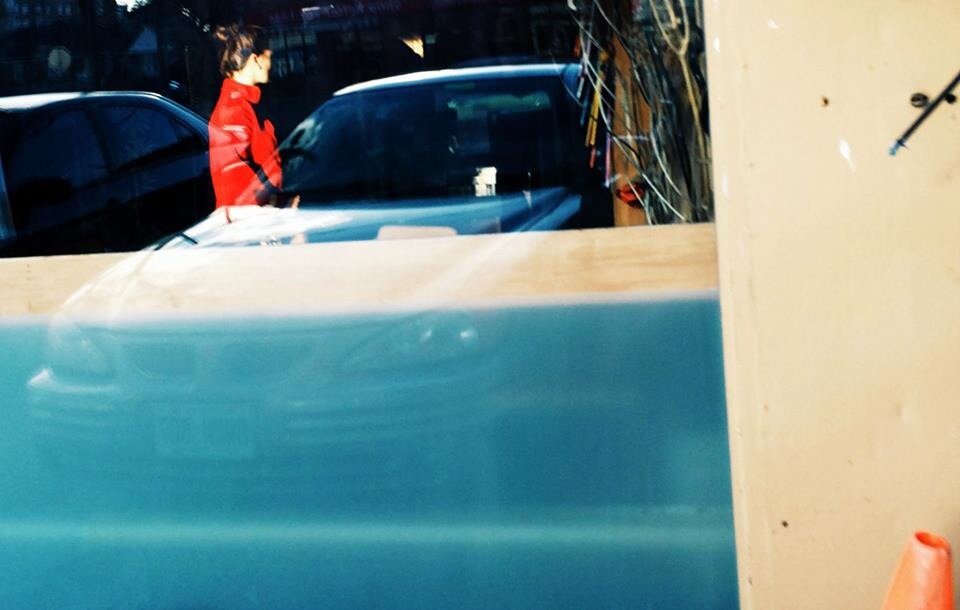
Where are you going, where have you been? Again, part of the series I spoke of earlier. This is dedicated to Saul Leiter, one of my favourite photographers and one whom I am only beginning to delve into thanks to a friend (Dan Cristea @konstruktivist) introducing me to his work. This is simply my attempt at seeing the world as Leiter did in his photos. If you don’t know his work, my God. LOOK! The woman in red later led to a short story I have begun writing about a girl who can swim through glass.

Where are you going, where have you been? Taken in Vienna, Austria. The North by Northeast departure of these two subjects just begs for a storyline, perhaps one of tragedy, but perhaps not without love? The man will assuredly die.

Where are you going, where have you been? Taken in Toronto. I have not finished with this photo yet…but she will most assuredly become a character in a story soon, or a poem. Her look is music to me, Chopin maybe , and she’s looking to leaving.
BP: Your series “Where are you going? Where have you been?” is an interesting one. Can you tell us more about it and your expectations of this series as you’ve listed it as one of you favorites? Altogether, do you feel you’ve accomplished your goals?
MW: Sure! So, this series basically centers on the relationship I explore between creative writing and photography. I will usually use the streets to inspire something in my writing, such as a character, a setting, a mood, or even conflict itself, if I’m lucky. Most of my photos feature human beings who are, usually, in movement and going from one place to another. I like to pose the question, once I’ve found an interesting moment or subject, of “Where are you going? Where have you been?” – and use these questions to lead towards some type of narrative, something tangibly poetic that I can fashion into a story: “Where are you going? Where have you been? Do you believe in God? In suicide? When you arrive at your destination, will you be greeted with a parcel, a bomb, a kiss on the lips?” – and on and on the process can go, depending on the actual shot I get. So far, it’s led to a few short stories or sketches and bits of poetry I have written, but nothing definitive, and I’m not really interested in that right now. The point is that I use this exercise as a way of shooting and a way of making the creative process between writing and photography both cyclical and reciprocal. One day, I will probably put together a handful of photos and texts that they inspired together in a formal portfolio, but I am not there yet.

“The camera is an instrument that teaches people how to see without a camera.” Dorothea Lange While I have been taking photos for over 15 years, I never had a serious camera until I got my iPhone 4S. Since then, I began taking my photography and my approach much more seriously, simply because I had, for the first time, a tool that could compliment my creative vision. This Lange quote has always resonated with me because it’s just so true. Photographers and visual artists may be equally cursed in this way, but my, what a blessing it is to be able to see magic almost everywhere you look. . .
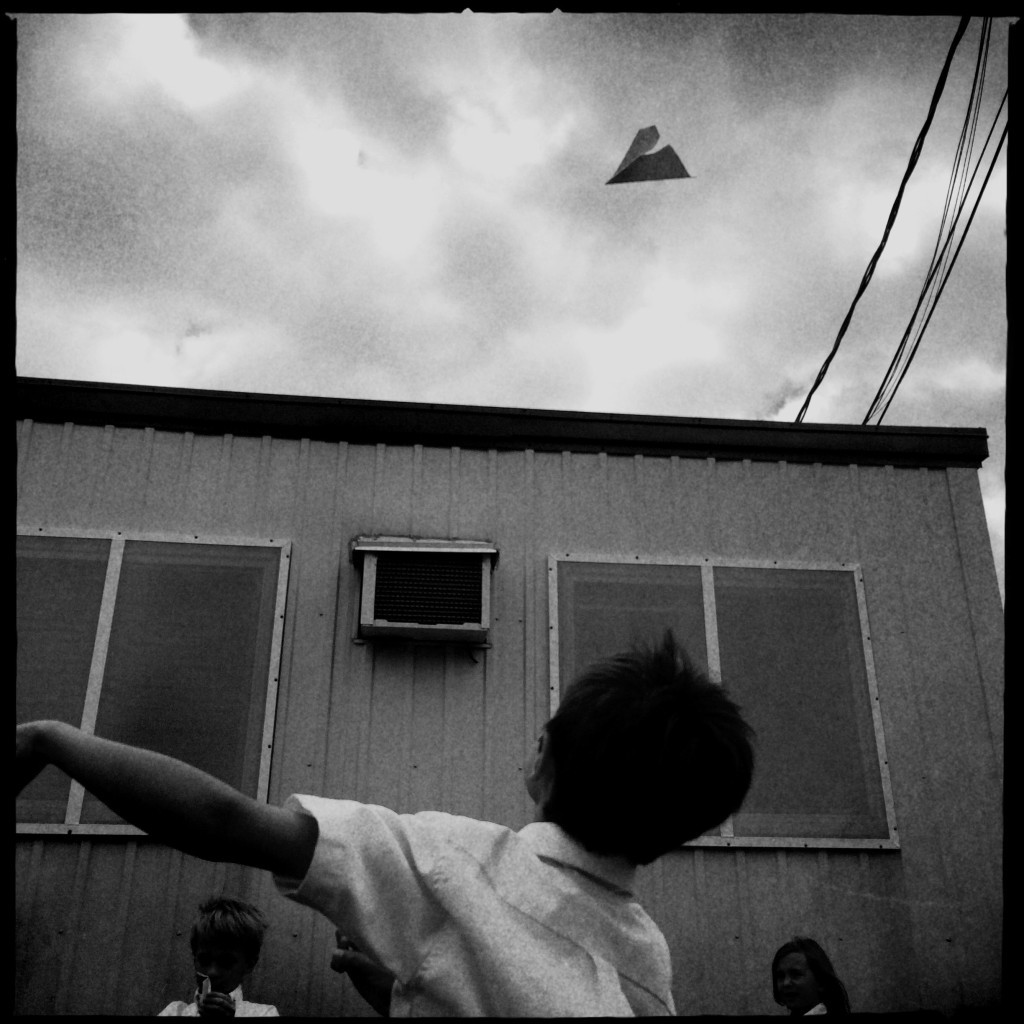
“Over” “Once you have tasted flight, you will forever walk the earth with your eyes turned skyward, for there you have been, and there you will always long to return.” – Leonardo da Vinci
BP: Who are your photographic inspirations and why?
MW: Well, hm. That’s hard to answer. There’s quite a few photographers whose work I admire and adore, both living and dead, e.g. Bresson, Gordon Parks, Saul Leiter, Vivian Maier, Dan Cristea, Markus Anderson, Amy Leibrand. But I think in terms of inspiration, it is this whole, revolutionary concept of social photography that we are bearing witness to as we speak. I mean, we are witnessing the democratization of the visual arts in a way that simply has never been seen before. Sure, there are criticisms to be made about the infinite flux of images – I get that. But you can’t deny the beauty and hope in the fact that more people have access to art and to tools to create visual arts than ever before! Photography, film, visual images – these are not just the fields of the privileged or experts or well-educated anymore. Anyone with raw talent who can afford a phone canget out there and do some absolutely amazing things with these tools! And not just that, but they can discover and reach out to other artists so easily, like we are doing now – they can learn from others, so purposefully– and all through the same device that they are using to create with! Like, ####! I think it was Koci that called this a “golden age” of photography and there just may be something to that. I mean, to think that this genre, photography, the arts, visual narratives, is so accessible to so many people now and the dialogue has grown so exponentially in terms of sharing ideas and inspiration – I think we are witnessing what will most assuredly be remembered / studied as an era of visual art production like the world has never seen. That’s just incredible to me! I just hope we embrace it now and continue to evolve with it. Think about it, can you imagine being able to travel back to the 16th century and say, “You guys are in the f###in’ RENAISSANCE! Do you get what that will mean later?” – I want us to look at what we, as artists, are experiencing now and see it as something that is significant in terms of the evolution of art in our society, rather than just a trend. And to think we are doing so much of this together! All of this, I feel, is spawning some brilliantly creative pieces and artists, which, again, begs reflection: we have the chances of seeing not just a handful of great photographers a decade, but hundreds, maybe more! This is so beautiful to me! And people are creating, producing, and communicating so prolifically. This doesn’t mean that everything is brilliant and I get the argument that art could grow saturated as a result of the influx, but who wouldn’t rather have more artists than fewer? The argument that the influx makes art less special is absurd to me because what you’re really stating with that is “there’s really only a limited amount of beauty out there to produce, or, there’s really only a limited amount to say, etc.,” which is illogical! Beauty isn’t finite, and neither is art. And let’s not get caught up in being ‘original,’ because, really, what has that EVER meant? I believe in raw creativity, and contemporary photography, especially mobile photography, is so very exciting to be a part of and witness right now and I’m excited to see where it takes us next. Again, just the fact that more people have such a powerful artistic tool in their hands than ever before – that’s just so inspiring and promising to me!
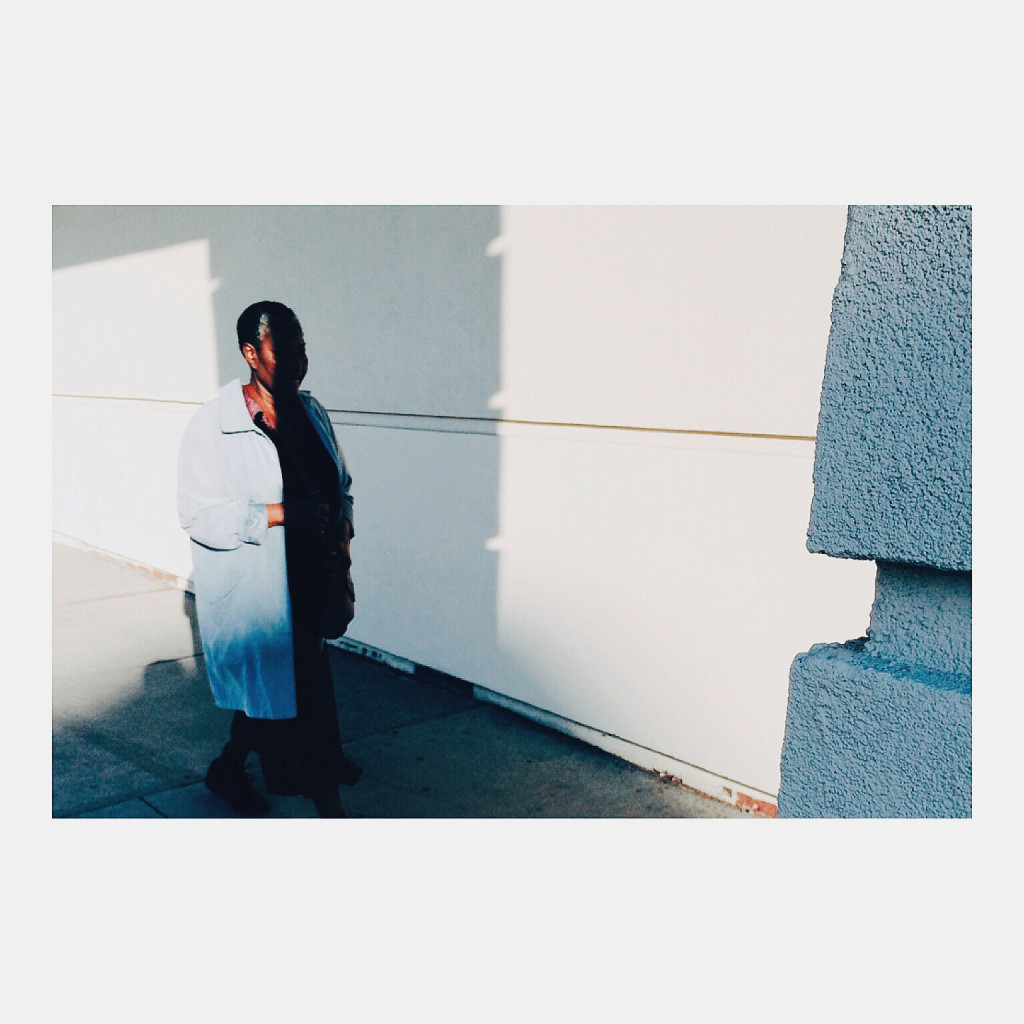
” . . . and I have not told half of what I saw.” – Marco Polo Taken in Toronto. This photo represents the inverse of the creative writing process that I spoke of earlier. For example, sometimes, I will take a photo and use it as a means to have me explore things I have read in the past. The ability to synthesize like this, between words, an image, and my memory, is quite interesting to me. I ended up with the Marco Polo quote and couldn’t stop thinking about it all night after the photo was taken. To think that Marco f###in’ Polo made such an utterance about the ‘discovery’ of a continent – and then to parallel that with the myriad of moments a photographer sees while out and about – and we only probably catch a fifth of what we see, for whatever reason. There is so much fucking beauty out there . . .
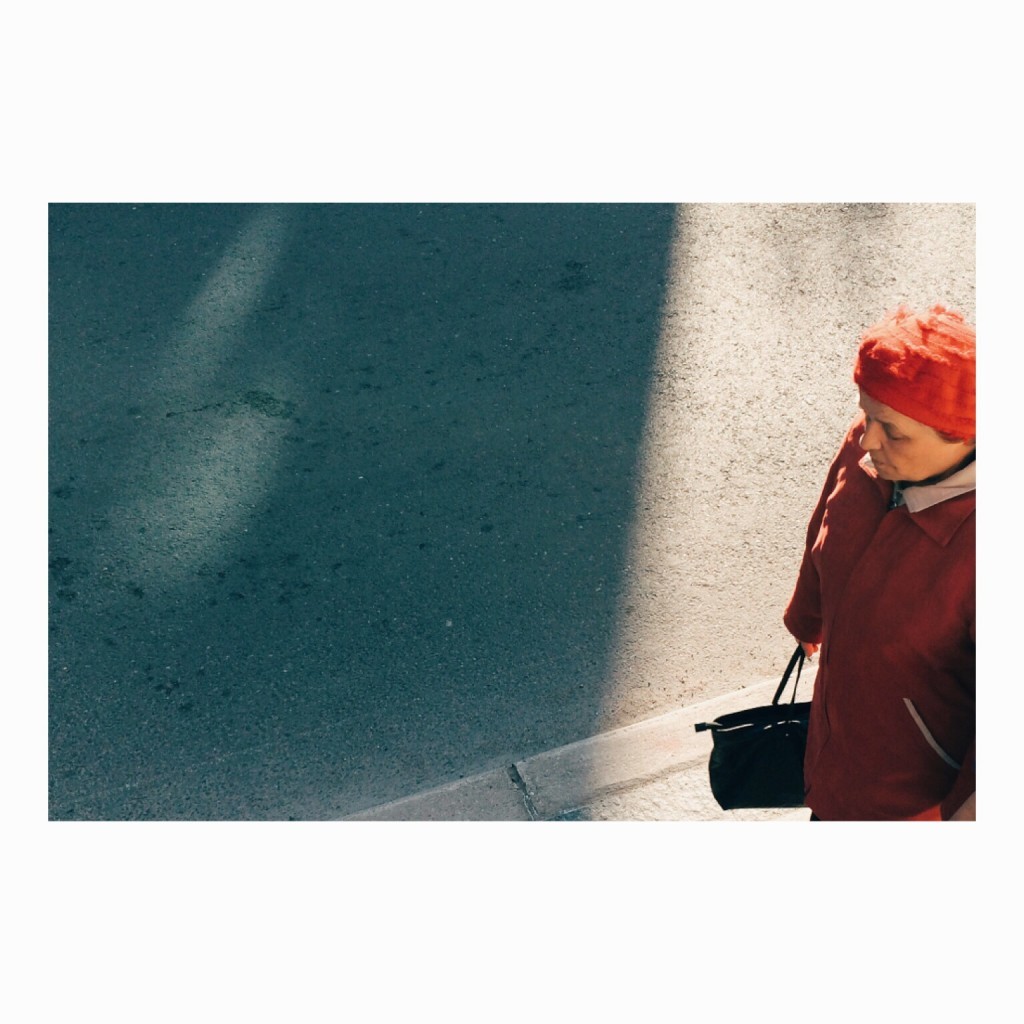
The Water’s Edge As Gabriel Garcia Marquez has taught us, sometimes light is like water. Sometimes, you tip tap into it, while at other times, you dive. Regardless, the pools are always there, wet, bright, and waiting for you. Please see his short story by the same name for advice on how to master the science of navigating on light.
BP: For new(er) street photographers, what advice do you have for them? Please provide any technical and artistic advice.
MW: Well, I am in no place to give advice, as I am still learning myself! But I can offer advice that I’ve either been given or just learned to give myself as I’m developing. So, shoot a lot! Shoot every day and learn from your mistakes, as well as others, even if by observation only. Study light and learn to make it work for you. Shoot for one month in the same hour of the day and do this for all of the day light hours, which should take you about a year. Dispel the myth that location is everything. Location is overrated. It’s about how you see, not where you are. Learn to see differently, and well. The stuff of good photographs – all that is out there! You just have to go find it, and you don’t need an expensive camera to do so. And I guess most of all, be confident in yourself and believe that you have something to say with your photos. Too many people have very little to really say about the world around them. Having so many tools to communicate now – that almost seems absurd, no?
Find Matthew Wylie: Instagram // Flickr // EyeEm // VSCO Grid
by Brad Puet | May 15, 2014 | Brad Puet, Featured Articles

“Lucifer Rocks On”
The City of Angels by BP
Email / Twitter / Instagram / EyeEm
* [REWIND] Originally published on We Are Juxt on September 7, 2012
Southern California is home away from home.
I took every opportunity to get out and shoot, especially the Streets of LA. It’s my first time to since finding how much I really like doing street. My son’s godmother (who is from LA) always told me I should shoot down there. That if I could get lost (metaphorically speaking) in Seattle when I go out to shoot, then LA will be totally crazy for me. Well my son’s godmother, this is for you!
I shot the streets. This time around I took down notes. Notes that helped me remember the moments I shared with folks when I talked to them, both strangers and family/friends and just my own thoughts and opinions – I wanted to make sure I caught the moments outside of the shots I took. I had the opportunity to walk one of Sam’s routes in DTLA with him. Sam is a street shooter who I totally respect. I got to see his process, his style. It’s great to see others at work. I was so caught up in watching him, that I only took a few shots and then my battery died. Earlier that day, I had shot the fashion district – specifically around Santee Alley. That in itself was a crazy ordeal. Santee Alley is a swap meet of sorts – used to be known to sell bootleg brands until it got broke down by the Feds. Rumor has it it is run by some international cartel. Not really hard to believe. I had a lady chase me down and call me out (I’ve never been called out before. She thought I was “filming/recording.” You just know they still trippin from the Fed raids). After this encounter, I noticed two guys following me and my cousin just about every where. It was nerve racking for sure. That’s definitely a “neighborhood block watch.” It was one of them stories I’m definitely going to share in another article. That one will be about some of the craziness of shooting street.

“The No-Music Ice Cream Man”
Sidenote: For all you street photography purists; only 2 of these photos was where I asked to take their shot. Can you guess which two?
I wanted to see what I could do in LA. Although time was REAL limited, I wanted to take some opportunities to capture what I saw and heard in the City of Angels. The light is real harsh mid-day. I wanted to try for those shots. All of these shots were taken either on Melrose, Venice Beach, Hollywood and Highland, or Downtown LA. All of them were taken between the times of 12-4 PM. The light is truly unforgiving during these times. I saw it as a huge challenge. I tried my best.

“Anyone able to take Spidey back to Burbank? Meet Hitch-hiking Spiderman.”
Hollywood and Highland. The famous Walk of Fame. Full of tourists. I MEAN FULL of tourists. It was overwhelming to be honest. We had just gotten back from visiting the “Wild Card Gym” owned by Freddie Roach, where Jamie Fox, Mark Wahlberg, and of course the pound for pound World Champion Manny Pacquiao train. Come out of the elevator from the parking structure and bam…OVERWHELMED by the tourists. Along with the tourists come the likes of Spiderman, Dora, Bumblebee, Samuel Jackson, Zorro…just a whole mess of people dressed up in these costumes for tourists to take pictures with…at a price. I tried to take a couple shots of these folks…one saying I owe money and the other (dammit all to hell it came out blurry) of Cat woman, flipping me off and calling me a whole mess of names with cuss words in the front. I even saw one of them “taking a break.” She looked nothing like a celebrity. My cousin whispers to me, “all the costumed folks are either homeless folks or drug addicts…you have to choose wisely to who you give money to.”
Ain’t that some shit.
This is not the Walk of Fame you see on the TV and movie screens. The removing of the masks and costumes is pretty indicative of the society we live. Without going into too much social commentary, we are all trying to live the good life, and some of us have to hide behind things in order for it to show some fruits of labor (shoot I’m in this bunch for sure).

“The Mannequin’s Mannequin”

“This photo is going to make you famous.” – Al, DTLA Street Musician
Downtown LA is rich with amazing architecture. Unused and abandoned, its a deserted land full of new highrises shadowing some great detailed old relics of the past. Forgotten to the Staples Center, the Walt Disney Concert Hall, and the new Cathedral, these buildings scream stories to those who try to listen and pay attention. I talked to a friend and his wife about it. They would tell me of stories of coming down with their parents, who owned a business in the area and even back then, remember being scared to come down after sundown. It wasn’t just the people in the area after dark, it was the buildings that shared its anger towards LA citizens.
“It was like the buildings, beautiful by way of architecture, turned into scary horror movie dwellings…the ones only the stupid people would want to break into.”
The city needs to replenish this area to make it vibrant again. DTLA is too beautiful to stay like it is. Who am I to say this though? It’s been this way for decades.
DTLA is where I really saw the parts where not too many tourists want to go. The “Skid Row” in DTLA is nothing to mess with. Sam recognized some of the homeless folks that he had taken portraits with and we took some photos of them. Again I was more enamored with Sam walking his streets. We came across a sidewalk with about 7-8 homeless folks. A couple of them singing songs. Sam approached them and a couple of them obliged with their photos being taken. The guitar player who was the more interesting of the bunch was real elusive. I didn’t want to push trying to snap his photo so I ended up talking to another man away from this bunch. He told me a couple of his stories despite not wanting his photo taken. He said these streets were hard, but since he’s lived on them his whole life just about (27 years) he didn’t really know any better. He just knows its hard because people like me tell him so.
“I’m still alive and thats really what counts don’t it man. I mean, it would be fucked up if you were out here taking photos of dead bodies and shit. I ain’t dead, by no means am I dead.”

“They know of each other, but don’t know each other”
Melrose Avenue was a typical spot for me. Boulevard for urban style and wear. It’s like the anti-thesis to Rodeo drive. I actually think its considered the Fairfax district. It’s supposed to be the alternative area. Reminds me a lot of Capitol Hill or the Ave in Seattle’s U-District. It’s the boutiques and the tattoo shops and other shops like this that give this street character. Street art lace the buildings and alleys that compliment the neighborhood persona. It was just OK for me. It wasn’t like I haven’t seen anything like it in any other major American city.

“Venice Beach 911”

“The Watchers”
Venice Beach. The infamous Venice Beach right?!? It was like I walked onto a movie set. Palm trees line out the beach horizon. Tourists and locals alike all in one spot. The latter trying its damndest to squeeze out a penny. Street performers, muscle builders, store vendors, tattoo shops, skate boarders, the basketball courts…all centered around the police station. I would say that the amount of police in Venice was based on a quota system for sure. Maybe 15-1, 20-1, general public to one police officer. Heavy concentration around the hustlers selling their hip hop CDs south of the basketball courts. Scene of “White Men Can’t Jump” and “American History X” plays in my head when I was walking through this part of the beach.
Many years ago when I had first come to Venice Beach, a friend of mine told me that there were days specified for when the “gangs” of LA would come out. For instance Saturday was the day the Bloods would come out. Sundays the Crips. It’s crazy to walk through and think of the under belly of places, like its a beach, really?!? There are designated “gang days.”
I think from the places I shot in LA, Venice Beach was the one that was like a playground feel for me (as far as shooting). It seemed that everyone really wanted to have their photo taken whether they knew it or not. It would seem that I was taking a candid shot and then afterwards walk away feeling like, “damn, did they know I was taking their photo?” It seemed like a show, a small amusement park at times. I actually heard a tourist tell his wife, “I think next we should go to the skateboarding area. I heard that they put on a great show over there.” His wife responds, “Sure but Muscle Beach is supposed to start with a few bodybuilders and I don’t want to miss that.”
My friend who told me about the “gang days” grew up in Venice Beach. She said this the epitomy of LA (at least to her). Los Angeles is a tourist trap, hiding all of its glory in smoke and mirrors. Sometimes you can tell its fake, other times it inspires you to become what you may think is real.

“The Dodgers Fan”
My friend, Chris, told me, “It’s like the Dodgers, right…either you love them or you hate them…if you love them, you are ride or die…you hate them, you can’t wait to see them falter…Los Angeles is exactly like the Dodgers. Actually the Dodgers is exactly like Los Angeles.” This coming from someone who was born and raised in Los Angeles.
Really it was fun to shoot down there. Possibilities were endless for a photographer. The City of Angels does not disappoint for sure.
So hopefully ya’ll enjoy the photos and enjoy my memory notetaking ramblings below.
___________
It’s this love hate relationship.
Boulevards seperate fast cars and money from street vendors and bootleg DVD’s.
It’s the beauty of America.
Gangsters who are classless, nameless, raceless, and faceless.
Their names can be Aniston or Acevedo. Chavez or Clooney. Kardashian or Kortajarena.
Their addiction can be money.

“We all love ice cream”

“The Frame”
The freeways are the veins; ill-thrust between pockets of countries that carry us – flush inside the ugliness of Pre-Americana and Post-New World Order.
405 to San Diego. I-5 to the Valley. Sunset sleep walkers searching for the next fix – on life, love, and hate.
We walk by them everyday with ticker tape parades and news channel slogans.
Homicide rates up, unemployment rates up, heat index up.
Human consumption up, human compassion down.

“So a hair stylist, his dog, and a photographer walk into a bar”
We became them in another life. I saw myself in the reflection of the window and I disappeared.
It’s the Maserati blazing down the 101; bobbin and weavin past us. Blonde hair, hands raised, celebrating nothing but the gas prices spent on their 6 digit whip.
It’s the Toyota Previa; full to the top with boxes of tourist paraphernalia; slang at the corners of the fashion district, hands raised, celebrating nothing but the chance to haggle down; stealing milk and bread from hungry children’s mouths.
I saw the real citizen. Ugly with dislike for Obama and Romney. 4 for $4 sunglasses, tipped at the point of the nose, slip middle finger – disdain for anything other than Los Angeles. Now I understand the love for the Dodgers and the Lakers. They represent the golden ticket. It’s the stars in their eyes.
I can hear them when they wake up in the morning and tell themselves, “I’m gonna make it someday.”

“Hats and Agua”
It’s her love for being in this dirty moment. His want to get that hit passed his costume uniform standing on the stars of Hollywood as a fire truck sits in wait for the next heart attack. It’s chance to give a show to the masses. That Hollywood sign up on the hills hides their addiction real well.
I saw the real citizen. Louis Vutton and Deja Vu sellin’ the same shit to all of us. It ain’t about the backroads, it’s about the quick slant to get the fuck out.
Cat woman by day, stripper by night.
Spider man by day, dealer by night.
Seek the shade, the sun is unforgiving. It’s light will show us the truth and noone wants to hear it. Don’t go downtown in the dark. You may not come out. It’s been dead there for years. Those people been dead there for years.
There was an earthquake the other day in Beverly Hills. It gave the Kardashians type folks a chance to get out to the hood. Ryan Seacrest has another idea for a reality show. It’s him looking at himself in the mirror. It’s pretty fucking dramatic. and real.
It will probably only last one season. The networks don’t want this kind of shit. Leave it to the indie studios. They aren’t in it for the money.
If they do it’s real low so watch you’re back.

“Live for Now”

“The Modern Day Samurai”
The homeless become landscapes and structures. Step over them, or around them. They are mute because when they do choose to have a voice, it ain’t loud enough for anyone to hear.
What you doing man with that camera phone? This ain’t some child porn shit right? It’s not, then take a shot of my good side.
Play me a song again.
Dance man, Dance.
Some angels here choose not to fly anymore, others are always flying above us, they just don’t know where to land.

“Meditations and Lines”
I pieced as best as I could the thoughts and lines I wrote down. I didn’t want to make each line a caption for a photo as I think all the captions could work for any particular photo. I hope ya’ll dig it.
SHOUTOUT to the LA Folks/ Shooters. Next time hopefully we will shoot together.
OH yeah…I love my family!
Peace.
by Brad Puet | Jan 29, 2014 | Brad Puet

Members of the Legion of Boom Enters the Loudest Stadium in the World; DeShawn Shead #35, Kam Chancellor #31, Richard Sherman #25
On the Sidelines with the Seattle Seahawks and the Nokia Lumia 1020 by BP
I have had the opportunity to shoot both college and professional football with my smart phone – the Nokia Lumia 1020.
I’ve had to re-read that opening sentence a few times just for it to sink in. It’s crazy talk to say that I have been able to cover a PAC-12 college football game much less also cover an NFL professional team with all access press credentials.
Oh the places that we can let these phones take us.

12s: Cheering on the Greatest Team in Franchise History
My Football Story
I have been a football fan and fanatic since I was 4 years old. I remember my first football given to me by my dad before he went out to sea for the Navy. It was a San Diego Superchargers football. I loved that thing and carried it everywhere. At the age of 6 I fell in love with the Miami Dolphins. I loved watching Dan Marino make plays by throwing to Mark Clayton or Mark Duper – the “Marks Brothers.” From kindergarten to 8th grade, my best friend and I would play school ball everyday, whether on the school playground or the neighborhood street or running across to the high school football field. I played in high school and played shortly in college until blowing out my knee literally in the first few weeks of the season. I never played organized ball again.
I still remain a fan.
I’ve lived in the Seattle area since 1987. Steve Largent, Curt Warner, Jacob Green, Kenny Easley, Matt Hasselbeck, Marcus Trufant, Lofa Tatupu, and Walter Jones were my new heroes of the gridiron. I fell in love with the Seahawk logo, incorporating the native american culture in an appropriate way. I was a fan even during the 2-14 season (1992), a fan during the last 13-3 season (2005) and a FANATIC this season.
I am a part of the 12s. My 5 year old son is a part of the 12s.
Although he doesn’t understand the game fully, the excitement that he sees from me enables him to participate by showing his own enthusiasm. After the Seahawks lost to the Arizona Cardinals, I was a grumpy wreck. I came home and there he was in his Hawks gear; wearing his Marshawn Lynch jersey and carrying his Seahawk football. He came up to me, gave me a hug and a Hi-5 and said, “Dad, don’t worry. The team won’t let you down again. It’s only one game.”
As a father, this is what football has become.
My childhood is now shared with his childhood. Our love for the game makes watching it that much more beautiful.

Football is a family affair
The Game
In order to shoot the game of football with your smart phone you really have to prepare yourself for the game. Whether it is taking photographs of your child playing flag or peewees, high school football, college or professional level, you have to understand the flow of the game. By knowing the flow and paying attention to the direction of the game you’ll be able to stay ahead of a very fast moving game. I position myself according to the flow.
When the team is on offense, I position myself in between the team and the end zone. The game play will be coming towards you and you get a chance to capture not only the action, but the players. If you’re able to get a shot of a players face, you’re working towards a really good photo. On offense you should know that the quarterback is going to do a few things; hand off the ball to the runningback, throw the ball to a receiver, take it himself for a run, or get pummeled by the defense.

Jon Ryan #9 and Stephen Haushka #4 are Special Teams Heroes
When the team is on defense, I stay behind the defense. The other team’s offense will force the defense to react and your photos should reflect that. Much like on offense, you’re going to look for certain things; they are going to tackle, intercept, or cause/recover a fumble. You’re the person to try and capture those things.
The game doesn’t just consist of following the actual game. The game is nothing without the storylines. The fans, the interaction of coaches and players with fans, the cheerleaders, the mascots; all of these things make up the game of football. Because a smart phone has some limitations and you’re just not going to be able to get great action shots close up, this component is crucial for folks to be able to capture the game of football. Tell the story of the game, the players, and the fans, and you’ll accomplish telling a great story of the great game of football.

Taima the Hawk: Taima leads the team onto the field every home game!
Football and the 1020
Make sure to bring gear to support you throughout the time of the game. I brought with me a couple battery chargers one of which being the Nokia cameragrip. The cameragrip is crucial because it has the attachment for putting the phone on a tripod or in this case a monopod. I always have my monopod with me. Like all cameras, camera shake can make or break a photo. The 1020 has great stabilization but having a monopod helps in diminishing the chances of camera shake and blur in your photos.
I used the native Nokia camera app for these photos. The manual controls for this app are great and I’ll show you photos along with the settings I used to capture the photos.
*Note: The 1020 saves in RAW format. The Nokia .DNG files respond really well in post process.

Sports photography can be done with mobile phones
The Settings
The manual settings that I used for shooting the play on the field are; white balance, ISO, and shutter speed.
All of the above are variables and are inter-related since changing one requires changing at least one of the other two and, in some cases, all. Since trying to deal with these variables is very confusing its best to choose one as a “constant”, leaving only a few of the variables more manageable. I suggest setting an ISO and then not touching it unless absolutely necessary. I went with 1/400 since it was an overcast day. Raising the ISO on your camera will allow you to shoot at a higher shutter speed, giving you a better chance of getting the perfect shot – which for me was freezing the action. The higher I went with the ISO, the more noise the camera captured. I want to diminish the amount of blur but not compromise the shot with a bunch of noise. 1/400 was perfect for me.
The light sources in Century Link Stadium change at every view and angle. The looming artificial light from the stadium and the natural light from the sun and clouds made it difficult to capture the true colors on the field with a smart phone. The 1020 helps in making it easier for the photographer to get the best color and true whites from the sidelines. I set my WB on the cloudy setting. It seemed to keep the natural whites and colors that I saw away from the lens.
We Are Juxt has many tutorials in using the Lumia 1020.
I suggest perusing these tutorials here for more details on maximizing manual settings for your perfect shot.
 The Pile Up: As you can see from the shot, I was pretty close to the action. These guys were literally 8-10 feet away. The action was so quick that if any of the players continued to run through, I would’ve been a casualty.
The Pile Up: As you can see from the shot, I was pretty close to the action. These guys were literally 8-10 feet away. The action was so quick that if any of the players continued to run through, I would’ve been a casualty.
Shutter Speed: 1/904s, ISO: ISO400, White Balance: Cloudy

Marshawn Lynch #24: This is another shot that was close to the action. The incompleted pass almost sent the ball towards my head. Luckily it didn’t and luckily Beast Mode didn’t run me over.
Shutter Speed: 1/490s, ISO: ISO400, White Balance: Cloudy

Russell Wilson #3: The amazing Mr. Wilson is known for running around defenses. Although this wasn’t a scoring run, he stifled the defense with moves like this all game.
Shutter Speed: 1/257s, ISO: ISO400, White Balance: Cloudy
The Final Score
It was an honor to be able to document so many great events this past year. From MTV’s Video Music Awards Red Carpet to the Seattle Seahawks, I never thought in my wildest dreams that I’d be able to cover these events with my camera phone. My friends, Daniel Hour (formerly of University of Washington Athletics), Jordan Stead (Seattle PI photojournalist), and John Lok (Seattle Times photojournalist) have both supported me and the community of mobile photographers in Seattle. They understand that photography is about telling a story and people can do it with their camera phones as well as their big cameras.

12s: Scaring the Opposing Offense, Energizing our Amazing Defense
Again, “Oh the places that we can let these phones take us.”
In just a few days, the Seattle Seahawks will be playing in the biggest game of the year; the Super Bowl. For this “final score”, I wanted to wish them a great game and to come back home to Seattle the champions that the city, this region and its citizens (as well as all the 12s around the world) know they are.
Go HAWKS!
*UPDATE (February 2, 2014): THE Seattle Seahawks are World Champions! The “Final Score” was 43-8!

Football is not just about gladiators, it’s about brotherhood.
Other Seahawk Posts on We Are Juxt:
Hipstamatic: The 12th Man (2012)
Go Seahawks: The 12th Man Sendoff (2012)
by Brad Puet | Nov 22, 2013 | Chops with BP, Featured Articles
Through the (Google) Glass: Linda Stokes by BP
I am one of the folks who run the We Are Juxt Twitter account. I see a lot of the photos that are tagged as well as shared for us to see. There are many great images and because of the shear volume it’s almost hard to find an artist on Twitter to feature on our site. Until recently! Linda had tagged a few of her photos one week and they were great. Then I realized that she was using Google’s Glass and was intrigued to learn more about her, her process with Glass, and of course her images.
Folks meet Linda, Linda meet the folks! – BP
I grew up in Texas and Oklahoma, and carry with me a great love of open space, with an unobstructed view of the sky. When I was 21, I went to graduate school in Fine Art at UC Berkeley and ended up staying in California for years, working in animation and special effects for the movie and tv industries. I directed commercials, music videos, fake TV commercials for SNL, and special FX for Sci-Fi movies . It was great fun, and I got to work with many of the best in the business. I came back to Oklahoma and the Chickasaw Nation for a family emergency, and realized I was ‘home’.
As a life-long artist, I love to draw, especially from life, Sometimes I teach college classes in life drawing, design or Art History, but mostly I just do my Art. I show my work regularly in Dallas, and the southwest, but the ‘gallery system’ feels like a dying breed.. Social media online is a great way to share what I’m working on, and I’m pleased to have over 45,000 followers. Currently I’m looking at ways to bring my mobile photography into the 3rd dimension, and thinking about how this habit could be monetized. The show I’m in right now, I shot the piece with glass, and worked back into a print with drawing.
Music is part of my life and I enjoy listening to world music that has a Native feel to it when I’m editing. Though I love oldies/ nineties music, hip-hop and reggae. I had the pleasure of spending time in Guatemala learning Spanish, and Austin, Texas for ASL, and I bagged a California Community College teaching credential, along the way.
Like most artists, I like perspective changes, and changes in perception. I meditate daily, and have been actively seeking to use my obsession with mobile photography as an exercise in pure seeing, or seeing ‘that which is ’ I see the sunrise every morning, and watch it set every evening. I spend much time watching the sky, looking at trees, plants and fellow creatures.
According to Kahlil Gibran, “When you reach the heart of life you shall find beauty in all things, even in the eyes that are blind to beauty.”

When I glimpse what I feel to be a distillation of beauty, I try to capture it from time, and drag it back to the construct, for display. I rely on my eye, and faint visceral tugs to know when to shoot, if I remember …and go into a place where external reality barely intrudes.( Once I’m finished shooting, I realize there are thorns sticking into me and I’m freezing.) Naturally I am addicted to this feeling, and hope to keep doing it for years.
When I was taking care of my mother while she died, a couple of years back, I longed for an instant mode of creative expression, that didn’t require lots of equipment or supplies. I’d had a show of new drawings in 2011, and participated in several gallery shows, but wasn’t interested in getting back into being bound to the desk or easel. Pretty soon I discovered the perfect tool was my phone, and began my experiment of trying to see and distill the beauty of now. My phone cams, and their attending editing apps eased my creative anxiety, and another rabidly obsessed Mobile Photographer came into being,
Last summer I went out to Google in Mountain View, Ca, and got setup with glass. (I got picked because a photo I put in their online contest February 2013 got thousands of hits and reshares.) The color and clarity of the Glass device shots are similar to my Samsung Galaxy S3. but it shoots hands free, by voice command and is a wider angle . The technology is a wild ride, fraught with instant elation when it works right and you get the shot , and abject misery when it screws up… there are so many layers to keep together. I have my Samsung GalaxyS3, iPhone, iPad, and Glass to keep charged and functioning smoothly, and then, there is the never ending task of staying on top of the seemingly constant updates, where once again, your favorite apps appear unfamiliar, and have new bugs.
One photo usually isn’t enough to work through a concept, so I tend to work in series. When I saw a wonderful Mack truck by the side of the highway, I felt that its ominous qualities could be better appreciated if my legs, in red heels, were in the foreground. Juxtaposed so to speak. This began my “Heel Overhead” series, which includes my legs in front of various presenting pieces of large equipment. I did one with a big Android statue at Google HQ as my first shot through glass. A lot of jaws dropped, but I just HAD to.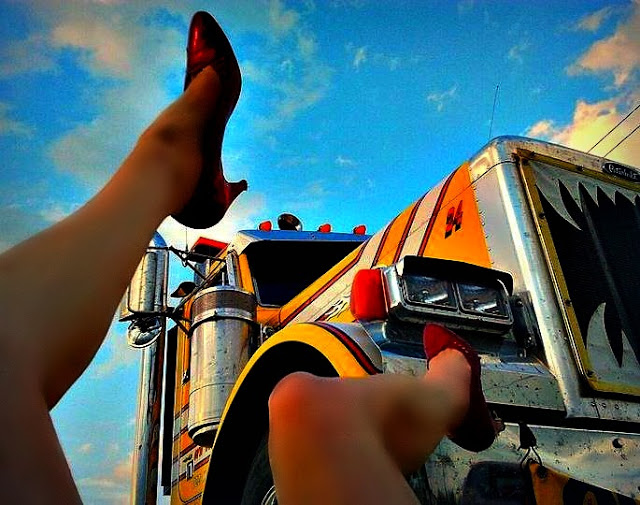
I like driving around looking at things, and love using my car in my work, whether shooting through the windshield or getting out and shooting the car in a cool spot. I love shooting rain through the windshield, and shooting with Glass is hands free, easier while driving. I try to catch those places in the road where you can’t see where the road ahead goes, or if its even there.
I’m back living in the middle of nowhere, with vast expanses of earth and sky, and the wonder of new love. My partner and I are exploring our own construct of what life and love can entail, in the middle of nowhere, Oklahoma. We are on some acreage, with no city services, no TV, a wood stove for heat, and its awesome!
My favorite Inspirational Hero has always been Che Guevara, whose very spirit embodies the idea that one person taking actions from the heart can change things. When I was young, I got to meet and hang out with numerous artists and writers who were true to their own instincts, notably Andy Warhol, Williams Burroughs and Peter Voulkos. People who take action inspire me, and the Occupy movement, and Anonymous are heartening. In my own family, my Granny inspired me with her ability to do whatever needed to be done, with what she had on hand. She grew vegetables, milked goats, made butter, sewed clothes without a pattern, and could handle a huge chainsaw into her seventies.. Throughout her life, she continued doing things she’d never done before, like finally getting her driver’s license at an advanced age.
Most of my shots are through glass, at least partially. I wear it when I drive, and when out shooting. It works pretty well inside the car, if you keep your tunes dialed down. It has voice activation, so you don’t have to touch it to shoot, as long as it can hear you.. It doesn’t understand well in high wind, and I’ve had to manually shoot it in storms, which is cumbersome.
There is no viewfinder in the glass, and you don’t see anything when you are shooting. You just look, and when you see a shot, you say “Okay Glass, take a picture” The device is above your right eye, held up with a nose piece on a metal band, like wearing glasses. There are other commands, for shooting video, sharing to your Google+ circles, and adding captions. You can check your email, message people, use your phone, see what’s happening on your Google+, Facebook or Twitter streams, check the news, get maps and directions, find public transportation and see how long it will take you to get somewhere. Its tethered to your phone as a bluetooth device.
That’s all pretty cool, but the best thing is shooting hands free. Around here, I’ve been asked if it is a medical device.
My photos all auto-upload to a Picasa web album on Google+..thats android, iphone, ipad and glass. If I want, they can be edited with the Google+ editor, which is really Snapseed. Or, I edit them on the phone, and my first choice is Snapseed. This works great for shots that just need a little tweaking.
My editing style is intuitive, and begins when I’m shooting. Like a lot of people, I enjoy combining my favorite images. I shot the tractor, screen left , through glass, with the intent of pairing a perfect cloud in the blank area above. The cloud appeared later, and I framed it until it looked like it would rock with the tractor, and snapped it with my iphone. I took both images through Snapseed ‘Tune Image’, and then to an image blending app on my ipad.,
PhotoBlender, and Image Blend are useful. There, I blended them in an old school DX, and took the composited photo back into Snapseed for texture and a little drama.
Other apps I like are Photo fx Ultra, for its neutral density grad, and color grads, that can really add subtle color to landscapes. I also enjoy LensLight for popping lights in night shots. On android I like Pixlr Express, and several filter apps… ( they were wiped off my phone when I had to get it reset to factory settings last week. Now I need to reinstall those…never a dull minute!) I told the Glass Developers last summer they needed to have editing apps, at least Snapseed in the glass, after all Google owns it, too. I’m betting in a few months when my glass updates, it will appear. The thing that makes my editing a pain is Android vs Apple. I use them both but they don’t make it easy.
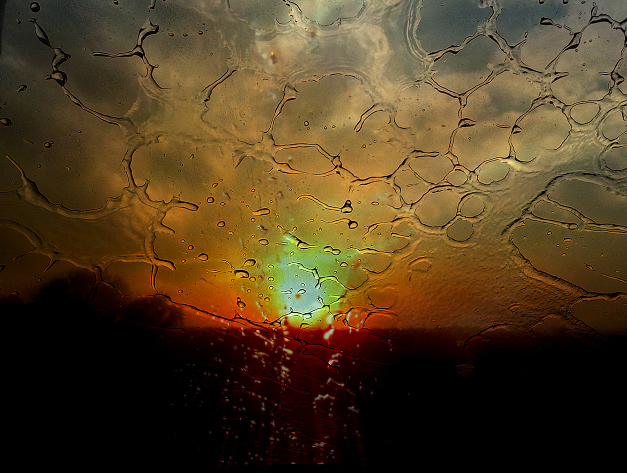
Nature always inspire me, and so do other mobile photographers, with the different ways they glimpse their worlds. It totally rocks to be able to see work from all over the world on photo social sites. I believe this is Fine Art of now. Its new, and unsullied by rules or tradition. Its instant, and as available as the creative spirit in us all.
Find Linda and her work below:
Facebook // Google+ // Pinterest // Twitter
by Brad Puet | Nov 8, 2013 | Brad Puet, Featured Articles

“The mobile photography and arts community is life in Technicolor. I hold all these little frozen moments in time in my hand every day. I get to experience the thrill of discovery, the pain of loss, or the joy on a child’s face as if I was there. This community of artists pushes me in ways I’ve never been pushed. To create, to capture, to evoke emotion. But also to tell my story. To share my own victories and defeats, to be open and bare on a regular basis. Our lives are a beautiful, living creature and because of mobile photography I am intertwined with people I will never meet face to face.” – Anna Cox, a mother and an artist from Central Kentucky. You can see her on Instagram and EyeEm as @starklifephoto.
Mobile photography: Built on community by BP
The community of mobile photography has broadened how we communicate with one another. Our interests are now shared with an increasing amount of people, followers or audience (however you choose to define it). Our reach to others has been extended on a global scale while our interactions have evolved on an emotional scale. We are able to build relationships, based on support and our common ground.
We are now part of a world in which mobile technology touches almost every aspect of our lives. Innovative, connected devices have fostered a community of “creatives” who learn, teach and consume the art of mobile photography. The idea of connectivity is centered in the here and now, helping us interact with people impulsively and instantaneously.
In June of 1997, Philippe Kahn invented the camera phone as we all know it. The premise for this invention for him – to document and share with family and friends the birth of his daughter – also marked the beginning of the mobile photography community.

“I think from the beginning, the mobile phone camera was created as a way to share immediate, ‘disposable’ images with close friends. I don’t think anyone really planned for the App Store and for a bunch of stubborn photographers — professional and non — to consistently create these really outstanding pieces of art. It wasn’t that photography was new. I think a big part of iPhoneography’s early success was that it was the first camera of decent to good quality that was always with you. It was the first good camera that could photograph a scene without really affecting the subject much. Above all, the iPhone was and still is a very personal camera.” – Marty Yawnick, freelance graphic designer from Dallas/Fort Worth, and the editor for Life in LoFi
This burgeoning community has been enthusiastic about sharing their work from the start, first through small, individual blogs and the innovative (at the time) Flickr share site. The creativity they exhibited with their camera phones was amazing. There were many people creating stunning images, curating their art on these accounts and building relationships with like-minded creatives. They began to develop the core functions of the mobile photography community: sharing, engaging and consuming images. From inception, it was about the art, but more importantly about the camaraderie surrounding the art.
Enter social photo-sharing platforms Instagram and EyeEm, and the doors to this small but growing community were opened to the rest of the world. Sharing became instantaneous, and the community discovered a new addiction to engaging and consuming photographs. Images were uploaded at an astronomical rate. What once was a slow process of downloading to a desktop, then posting onto a web-based site, became shoot and share immediately. The community began to broaden. There were a million stories being told.

“Within the rapidly growing community of mobile photography, amateurs and professionals alike, from around the globe, document, share and relate. These communities foster friendships, engender support and facilitate their members to push the boundaries of what mobile photography can be as well as what it can hope to accomplish.” – Matt Coch is a New York-based photographer who goes by the moniker Brooklyn Theory.
Exploring the meaning of ‘community’
Community means a “unified body of individuals,” says Merriam-Webster. It connotes inclusion and similar beliefs within a collective context. We find ourselves identifying as part of the mobile photography/iPhoneography/Droidography/ Windography community.

“The most important thing to me is seeing happiness and emotion in a picture. I have missed a lot of that since my mom died. When I met my husband, I started to see the happiness again. And then my son and daughter were born. But when I discovered photography especially with them, I just try to capture moments. Whether they are happy or sad. Or mad. Whatever emotion it may be. Nothing means more to me than my family.” – Melanie de Krassel is a mother from Los Angeles, California. She found photography through her iPhone and her favorite subject matter are her children.
Community is actually individual-specific, with an individual at the center. You, me and everyone else: we each have our own community.
At first blush, this may sound like a modern, individualistic, self-centered definition of community. For one thing, with this understanding comes the new understanding (for me anyway) that every individual I interact with today is the living, breathing center of their own community. This makes everyone significantly more connected, influential and powerful than they appear (and often know) in their individual forms. Every individual is the center of their own community.

“When I became involved with iPhoneography in February 2010, the community was active, smaller and more ‘underground.’ Then, Instagram hit, and then a lot of the activity moved there–away from Flickr, but it’s really hard to say. I know I noticed changes in traffic patterns for where people were spending their time as informally measured by comments, not just image sharing. Also, as Instagram became popular, more people were coming to Facebook to share photos. This was a big shift.” – Star Rush is a documentary and street photographer, writer, and educator from Seattle, WA.
We are living in a time when most of us are so flooded with imagery and information as individuals that we have no idea which end is up many days. This can cause us to over-rely on the published ideas of distant experts and to undervalue those we’re directly connected to as well as our individual selves. Sure there are technical aspects that we can learn from others. Sure there are new discoveries that can help us hone our craft. In the context of community, we all have a stake and a contribution to make.
We are so much more than we can know we are or be as individuals. Community wraps us in the surprise and delight we need to laugh, play, relax and to come to know more of our whole, true, beautiful selves. This hasn’t changed since the word community was first spoken, because this doesn’t need to change.
I think that’s why community persists and why it will continue to persist, despite our precarious piles of individual fears.

“The mobile photography community, to me, has become an essential part of my creative process. I don’t know where I’d be as an artist if there wasn’t one, I’ve learned so much from others I’ve met along the way in this game that has helped mold me into the photographer I am. It’s really cool to have found so many people who share the same interest through a cell phone app, kind of crazy when you think about it and how far the technology has come. I’m curious to see where all this will take us in the next few years, we’re already off to a good start and I’m honored and proud to be a part of it.” – Mike Hill, mobile photographer originally from New Orleans, Louisana.
Community is who we are. It’s why we last. It’s always with us, like the found, smooth and treasured stones in my jacket pockets that show up to surprise and delight me again and again.
My stones have names. Your stones have names.
These stones provide us friendship, mentorship and inspiration. They provide us a glimpse of humanity through a technological window.
We develop these relationships on behalf of a community that loves to create, learn, share and connect. We are touched by all these stones on the basic human level. I hold mine close to me, in my pocket, and get excited when they share with me the joys, the heartache, and the humor of their daily lives.
How can I even quantify how they participate in my definition of community?
That’s just how we roll.
That’s community.

“The community and the sharing are key answers in my idea of being ‘connected’ worldwide. You grow your passion looking at a billion of photographs everyday, and that is the biggest silent, hidden change for me. More ideas, more interactions, more self-confidence. Your passion grows. Your addiction to the ‘art’ grows. Your ‘eye’ begins to see what was hidden before.” – Alessio Castaldo, late and great photographer amd original Juxter from San Benedetto del Tronto, Italy. He was an advocate for mobile photography and was co-founder of The Minimals, which seeks the use of fundamentals in the mobile genre.
———————–
*”Mobile photography: Built on community” was originally posted on DPR Connect on November 21, 2012




































 The Pile Up: As you can see from the shot, I was pretty close to the action. These guys were literally 8-10 feet away. The action was so quick that if any of the players continued to run through, I would’ve been a casualty.
The Pile Up: As you can see from the shot, I was pretty close to the action. These guys were literally 8-10 feet away. The action was so quick that if any of the players continued to run through, I would’ve been a casualty.









